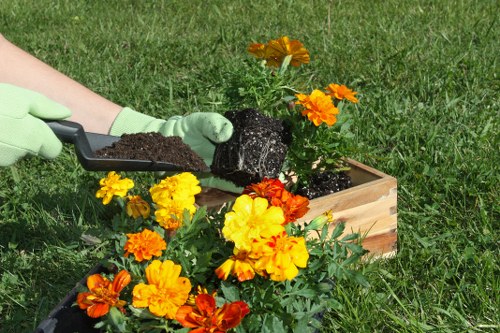Lawn Mowing Leaves Green: Achieving a Lush and Vibrant Yard

Maintaining a beautiful, green lawn is a goal for many homeowners. A well-mowed lawn not only enhances the aesthetic appeal of your home but also contributes to a healthy outdoor environment. Understanding the relationship between lawn mowing and maintaining green leaves is essential for achieving a vibrant and resilient yard.
Regular lawn mowing promotes healthy grass growth by encouraging the blades to thicken and spread. This process helps to prevent weeds, reduce pest invasions, and improve the overall appearance of your lawn. However, to ensure that your lawn remains green and lush, it's important to mow correctly and follow best practices.
In this article, we'll explore the key aspects of lawn mowing that contribute to maintaining green leaves, including mowing height, frequency, and techniques. We'll also discuss the tools and equipment needed, as well as tips for addressing common lawn care challenges.

Understanding Lawn Mowing and Its Impact on Green Leaves
Lawn mowing is more than just trimming the grass; it's a critical component of lawn maintenance that impacts the health and appearance of your yard. Proper mowing techniques can enhance the green color of your grass, while improper mowing can lead to a dull, unhealthy lawn.
When grass is mowed correctly, it stimulates growth by removing the top portion of the blades, allowing nutrients and sunlight to reach the lower parts of the grass. This results in a denser, more resilient lawn that can better withstand environmental stresses.
Conversely, mowing the grass too short or using improper techniques can damage the grass, making it more susceptible to diseases, weeds, and drought. This can lead to a brown, patchy lawn that detracts from the overall beauty of your property.

Proper Mowing Height for a Green Lawn
One of the most important factors in maintaining green leaves is setting the correct mowing height. Different types of grass have different optimal mowing heights, but generally, keeping your grass at a higher level offers several benefits.
Benefits of Higher Mowing Heights
- Enhanced Root Growth: Taller grass encourages deeper root systems, which improve drought resistance and nutrient uptake.
- Weed Suppression: A denser, taller lawn shades the soil, reducing the chances of weed seeds germinating.
- Improved Shade Tolerance: Longer grass blades can better withstand shading from trees and buildings.
- Greater Photosynthesis: More leaf surface area allows for increased photosynthesis, leading to greener grass.
As a general rule, cool-season grasses like Kentucky bluegrass and fescue should be kept between 2.5 to 3.5 inches, while warm-season grasses such as Bermuda and zoysia thrive when maintained between 1.5 to 2.5 inches.

Optimal Mowing Frequency
Determining the right mowing frequency is crucial for maintaining a healthy, green lawn. The frequency will depend on the grass type, growth rate, and seasonal conditions.
Weekly Mowing Guidelines
During the peak growing season, most lawns benefit from being mowed once a week. This helps prevent the grass from becoming too long, which can lead to thatch buildup and other issues.
- Cool-Season Grasses: Typically require more frequent mowing in the spring and fall when they grow vigorously.
- Warm-Season Grasses: Grow most actively in the summer and may need weekly mowing during hotter months.
In slower growth periods, such as late fall and early spring, reducing mowing frequency can help maintain the grass's resilience.

Best Lawn Mowing Practices
Adopting proper mowing practices is essential for keeping your lawn green and healthy. Here are some key tips:
1. Keep Blades Sharp
Dull mower blades can tear the grass, causing stress and making it more susceptible to disease. Sharpen your mower blades regularly to ensure clean cuts.
2. Avoid Cutting Too Much at Once
Never remove more than one-third of the grass blade in a single mowing session. Cutting too much can shock the grass and hinder its ability to recover.
3. Mow When Dry
Mowing wet grass can lead to uneven cuts and clogging of the mower. It's best to mow when the grass is dry to achieve a clean, even finish.
4. Change Mowing Pattern
Altering your mowing pattern each time you mow helps prevent soil compaction and encourages grass to grow in different directions, resulting in a thicker lawn.
5. Leave Clippings on the Lawn
Grass clippings can act as a natural fertilizer by returning nutrients to the soil. Leaving them on the lawn also helps retain moisture and suppress weeds.
Essential Tools and Equipment for Lawn Mowing
Having the right tools can make lawn mowing more efficient and effective. Here are some essential tools and equipment to consider:
- Mower: Choose between a push mower, self-propelled mower, or a riding mower based on the size of your lawn.
- Edger: An edger helps create clean lines along sidewalks, driveways, and garden beds.
- String Trimmer: Also known as a weed eater, it’s perfect for trimming grass in hard-to-reach areas.
- Rake: A rake is useful for collecting grass clippings and debris after mowing.
- Protective Gear: Wear sturdy shoes, eye protection, and gloves to ensure safety while mowing.
Addressing Common Lawn Care Challenges
Even with proper mowing techniques, lawns can face various challenges that affect their greenness. Here are some common issues and how to address them:
1. Weed Infestations
Weeds compete with grass for nutrients and water. Implementing a regular mowing schedule, along with proper fertilization and watering, can keep weeds at bay. In severe cases, consider using eco-friendly herbicides.
2. Pest Problems
Pests like grubs and insects can damage grass roots and blades. Regularly inspect your lawn for signs of infestation and use appropriate pest control methods as needed.
3. Drought Stress
Extended dry periods can cause grass to brown and weaken. Deep watering in the early morning hours helps grass develop deep roots and improves drought resistance.
4. Soil Compaction
Compacted soil restricts root growth and reduces water infiltration. Aerating your lawn annually can alleviate soil compaction and promote healthier grass growth.
Local Expertise: Leaves Green and Surrounding Areas
For residents of Leaves Green, maintaining a green lawn is made easier with access to local lawn care services and resources. Here are some of the closest areas to Leaves Green that offer unique features for lawn mowing and maintenance:
- Maplewood: Known for its lush residential lawns and community gardening programs.
- Oakridge: Offers specialized lawn care services focusing on organic and sustainable practices.
- Pine Hills: Features a variety of grass types suited for different climates and soil conditions.
- Cedar Valley: Home to several nurseries and garden centers providing quality lawn care products.
- Elmwood: Offers comprehensive landscaping services, including mowing, trimming, and fertilization.
- Birch Grove: Known for its scenic parks and open green spaces, perfect for lawn care inspiration.
- Willow Creek: Provides expert advice on lawn maintenance and pest control.
- Spruce Meadows: Features community workshops on effective lawn mowing techniques.
- Cherry Blossom: Offers seasonal lawn care tips to keep your grass green year-round.
- Redwood Terrace: Specializes in drought-resistant grass varieties for water-conscious homeowners.
Conclusion
Achieving and maintaining a green, lush lawn requires a combination of proper mowing techniques, the right tools, and attentive care. By understanding the impact of mowing height, frequency, and methods, homeowners can foster a healthy lawn that enhances the beauty of their property.
Additionally, leveraging local resources and expertise in areas surrounding Leaves Green can provide valuable support in overcoming common lawn care challenges. With dedication and the right approach, you can enjoy a vibrant, green lawn that stands out in your community.
Frequently Asked Questions
1. How often should I mow my lawn to keep it green?
During the peak growing season, mowing once a week is generally recommended. Adjust the frequency based on the growth rate of your grass and seasonal conditions.
2. What is the ideal mowing height for my grass type?
The ideal mowing height varies by grass type. For cool-season grasses like Kentucky bluegrass, aim for 2.5 to 3.5 inches, while warm-season grasses like Bermuda should be kept between 1.5 to 2.5 inches.
3. Can leaving grass clippings on the lawn help it stay green?
Yes, grass clippings act as a natural fertilizer by returning nutrients to the soil. They also help retain moisture and suppress weed growth.
4. What should I do if my lawn is showing signs of pest damage?
Inspect your lawn to identify the pests and use appropriate control methods, such as eco-friendly pesticides or natural remedies. Consulting a local lawn care professional can also be beneficial.
5. How can I improve the drought resistance of my lawn?
To enhance drought resistance, mow at a higher height to encourage deeper roots, water deeply but less frequently, and consider using drought-resistant grass varieties suited to your climate.